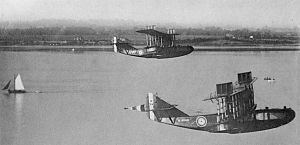Top speed 141 km/h Length 15 m First flight May 1918 | Wingspan 32 m Introduced 1917 Designer John Cyril Porte | |
 | ||
Manufacturers Gosport Aircraft Company | ||
Felixstowe f 5 reconnaissance flying boat 1917 full specs technical specs
The Felixstowe F.5 was a British First World War flying boat designed by Lieutenant Commander John Cyril Porte RN of the Seaplane Experimental Station, Felixstowe.
Contents
Felixstowe f 5
Design and development
Porte had designed a better hull for the larger Curtiss H-12 flying boat, resulting in the Felixstowe F.2A, which was greatly superior to the original Curtiss boat. This entered production and service as a patrol aircraft. In February 1917, the first prototype of the Felixstowe F.3 was flown. This was larger and heavier than the F.2, giving it greater range and a heavier bomb load but inferior manoeuvrability. The Felixstowe F.5 was intended to combine the good qualities of the F.2 and F.3, with the prototype first flying in May 1918. The prototype showed superior qualities to its predecessors but the production version was modified to make extensive use of components from the F.3, in order to ease production, giving a lower performance than either the F.2A or F.3.
Operational history
The F.5 did not enter service until after the end of the First World War, but replaced the earlier Felixstowe boats (together with the Curtiss machines), to serve as the Royal Air Force's (RAF) standard flying boat until being replaced by the Supermarine Southampton in 1925.
Felixstowe F5L
US built version of the F.5 with two Liberty engines numbers built:
Gosport Flying Boat
One of the ten RAF aircraft built by the Gosport Aircraft Company was civil registered as a Gosport Flying Boat in 1919 to appear at the First Air Traffic Exhibition at Amsterdam in August 1919.
Gosport Fire Fighter
Unrealised 10-seat version of the F.5 designed to carry men and material to the scene of a forest fire or emergency.
Gosport G5
Unrealised civilian version of the F.5 for two crew and six passengers, mail and cargo or either alone, fitted with two 365 hp Rolls Royce Eagle VIII, 450 hp Napier Lion or 500 hp Cosmos Jupiter engines. As the Fire Fighter above, the G5 could be adapted to operate in remote areas for locating forest fires and transporting personnel and fire-fighting equipment.
Gosport G5a
Unrealised smaller variant of the G5 with a 97 ft 6in span and 46 ft in length, for two crew and six passengers with an increased loading capacity.
Navy F.5
An improved Japanese version of the F.5 known as the Navy F.5 used by the Imperial Japanese Navy (IJN) between 1922 and 1930. The Hiro Naval Arsenal first licence-built the Felixstowe F.5 from October 1921, Aichi continued manufacture until 1929.
Hiro H1H
Hiro Naval Arsenal produced their own variant of the Navy F.5, as the H1H. The first version, Navy Type 15 with a wooden hull was powered by either Lorraine W-12 or BMW VII engines, the Type 15-1 had a longer wing span, whilst the Type 15-2 had an all-metal hull and four-bladed propellers. It was retired in 1938.
Short S.2
In 1924 the Air Ministry invited tenders for two hulls of modern design to suit the wings and tail surfaces of the F.5. Short Brothers submitted a proposal for an all-metal hull built of duralumin, then a largely untried and untrusted material. The aircraft was first flown on 5 January 1925 and delivered to the Marine Aircraft Experimental Establishment at Felixstowe on 14 March, where it was subjected to a series of strenuous tests, including dropping the aircraft onto the water by stalling it at a height of 30 ft (9 m): the aircraft withstood all trials, and after a year an inspection revealed only negligible corrosion. This succeeded in overcoming official resistance to the use of duralumin, and led to the order for the prototype Short Singapore.
Operators
United Kingdom
United States
Japan - (Post-war)
Specifications (F.5)
Data from Aircraft of the Royal Air Force
General characteristics
Performance
Armament
